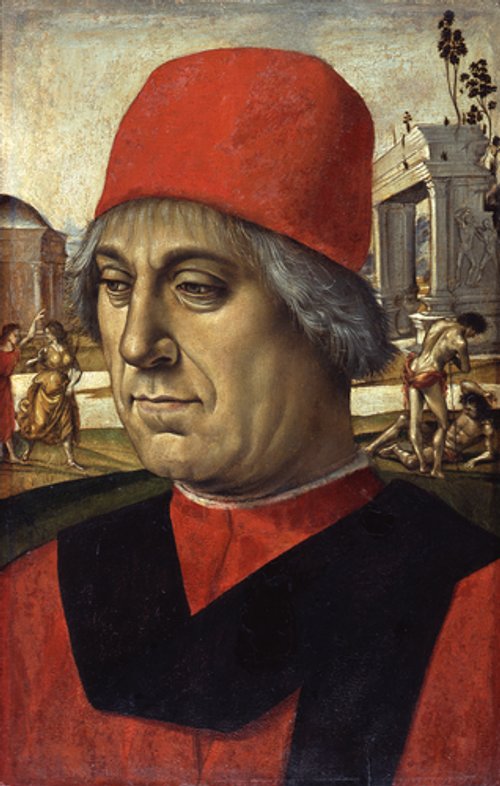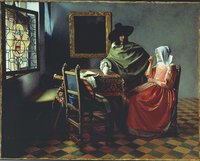Die Berliner Galerie ist besonders reich an Porträts. Die Entwicklung des italienischen Porträts der Frührenaissance läßt sich in ihr von Filippo Lippi über Antonio del Pollaiuolo bis zu David Ghirlandaio, Botticelli, Raffaellino del Garbo und dem Meister von S. Spirito verfolgen. Signorelli hat Porträts vornehmlich als Stifterfiguren in Altarbildern und als Kollektivporträts in seinen großen Fresken (Rom, Sixtinische Kapelle; Orvieto, Dom) verwandt. Autonome Porträts sind die Ausnahme. Ein Meisterwerk dieser Gattung und eines der berühmtesten Bilder der Galerie seit seiner Erwerbung in Florenz 1894 ist das Bildnis eines älteren Mannes, das von Mackowsky (1900) als Porträt eines Juristen gedeutet wurde. Der Dargestellte ist im Brustausschnitt gegeben; der Körper ist leicht aus der Frontalität gerückt, das Gesicht in Dreiviertelansicht nach links dargestellt. Er trägt eine rote Mütze und ein hoch geschlossenes rotes Kleid, wahrscheinlich den »lucco«, das lange florentinische Gewand. Darüber liegt eine schwarze Stola. Der Dargestellte ist von einem leicht erhöhten Standpunkt gesehen. Er blickt verschlossen, gedankenversunken zur Seite, nach unten, in der Kopfrichtung. Der Blick ist nicht fixiert, er ist diffus, nach innen gewandt. Die kraftvoll modellierten Züge sind massig, schwer und fest, von harten Falten durchzogen. Der Ausdruck ist energisch und zugleich gelassen. Von den humanistischen, antiquarischen Interessen des Dargestellten zeugt der für ein Porträt ungewöhnliche Landschaftshintergrund, in dem Signorelli links zwei laufende, antikisch gekleidete weibliche Gestalten vor einem antiken Tempel, rechts zwei nackte Jünglinge vor einem antiken Triumphbogen dargestellt hat. Diese erinnern mit der Rückenansicht der vorderen Figur und der Überschneidung ihres Konturs mit der am Boden kauernden Figur an die Gruppe im Hintergrund des Florentiner Tondos der Madonna mit Kind. Sie erinnern auch an die Ignudi auf dem berühmten Bild Pan als Gott des Naturlebens (ehemals Berlin, 1945 verbrannt), das wahrscheinlich mit dem von Vasari genannten, für Lorenzo de’ Medici gemalten Bild identisch ist. Signorelli stammte aus der in der südlichen Toskana, an der Grenze zu Umbrien gelegenen Stadt Cortona und war nach Vasari Schüler von Piero della Francesca, dessen Einfluß in seinem frühesten erhaltenen, dokumentierten Werk, einem nur fragmentarisch überlieferten Fresko aus dem Jahre 1474 in Città di Castello, spürbar ist. Von 1477 bis 1480 arbeitete er in Loreto, 1482 in Rom (Sixtinische Kapelle). In Florenz, wo er sich von 1484 bis 1492 aufhielt, wurde er vor allem von Antonio del Pollaiuolo beeinflußt. Sein spätes Hauptwerk sind die Fresken im Dom von Orvieto (1499/1503). | 200 Meisterwerke der europäischen Malerei - Gemäldegalerie Berlin, 2019 :::::::::::::::: The Berlin Gemäldegalerie has a particular abundance of portraits. The development of the early Renaissance portrait in Italy can be traced there from Filippo Lippi and Antonio del Pollaiuolo to Davide Ghirlandaio, Botticelli, Raffaellino del Garbo and the Master of Santo Spirito. Signorelli used portraits mainly as the figures of donors in altarpieces and as collective portraits in his great frescoes (Rome, Sistine Chapel; Orvieto, Cathedral). Autonomous portraits are the exception. A masterpiece of this genre and one of the most famous pictures in the Gemäldegalerie since it was acquired in Florence in 1894 is the Portrait of a Man, which was interpreted by Mackowsky (1900) as the portrait of a lawyer. The sitter has been portrayed breast-length; his body is shifted slightly from a frontal position, and his face is shown in three-quarter profile facing left. He wears a red cap and a garment reaching high to his neck, probably a lucco, a long Florentine robe. Above this lies a black scarf. The beholder sees him from a slightly raised position. He looks downwards and to the side, in the direction where his head is pointing, withdrawn and lost in thought. His gaze is not focussed but diffuse, directed inwardly. His powerfully modelled features are massive, heavy and firm, creased in hard lines. His expression is energetic and at the same time relaxed. To the humanist, antiquarian interests of the person portrayed attests a landscape background that is unusual for a portrait, in which Signorelli has depicted on the left two running female figures clad in the manner of antiquity in front of an ancient temple, and on the right two naked boys in front of an ancient triumphal arch. With the front figure viewed from behind and its contour overlapping with the figure cowering on the ground, they are reminiscent of the group in the background of the Florentine tondo of the Madonna and Child, also in the Gemäldegalerie. They also remind one of the naked figures on the famous work Pan as the God of Nature (formerly in Berlin, probably burnt in 1945), which is probably identical with the one named by Vasari and painted for Lorenzo de’ Medici. Signorelli came from the town of Cortona in the south of Tuscany, on the border to Umbria and according to Vasari was a pupil of Piero della Francesca, whose influence is evident in his earliest extant documented work, a fresco dating from 1474 in the Città di Castello that survives in a fragmentary condition. From 1477 until 1480, he worked in Loreto, in 1482 in Rome (Sistine Chapel). In Florence, where he spent the years from 1484 to 1492, he was influenced above all by Antonio del Pollaiuolo. The frescoes in the cathedral at Orvieto (1499–1503) are his late major work.| 200 Masterpieces of European Painting - Gemäldegalerie Berlin, 2019
de

